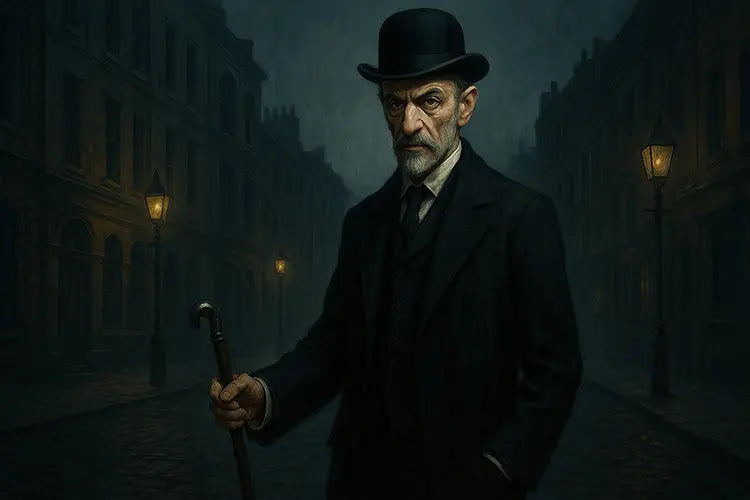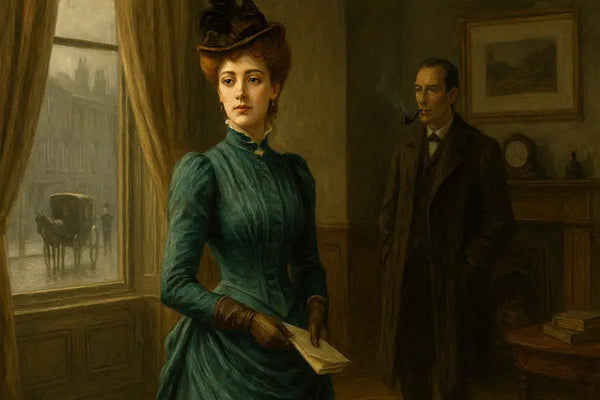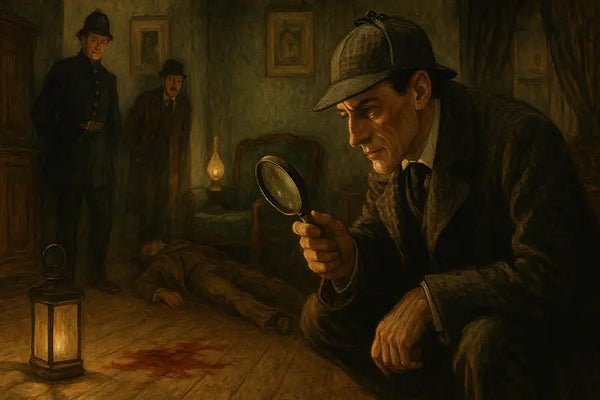In the pantheon of literary villains, few characters command as much respect and fear as Professor James Moriarty, the self-proclaimed “Napoleon of Crime.” Though appearing in only two principal stories within Sir Arthur Conan Doyle’s canon, this criminal mastermind has become synonymous with intellectual evil and serves as the ultimate foil to the world’s greatest consulting detective.
A brief history of Sir Arthur Conan Doyle reveals that he was a physician and writer whose medical background and fascination with logic greatly influenced his work. Doyle's experiences and interests shaped the creation of both Sherlock Holmes and Moriarty, with Doyle's portrayal of Moriarty as Holmes's archenemy establishing a new standard for criminal masterminds in detective fiction.
Professor Moriarty represents everything that Sherlock Holmes might have been had his extraordinary mental powers been turned towards crime rather than justice. This analysis examines the creation, character, and lasting influence of literature’s most celebrated arch nemesis.
Summary
• The Perfect Criminal Mind: Professor James Moriarty possesses a phenomenal mathematical faculty and extraordinary mental powers that rival Holmes’s own intellectual abilities, making him the only criminal capable of matching the great detective’s brilliance.
• Strategic Literary Creation: Conan Doyle created Moriarty specifically to provide Holmes with a worthy adversary and to facilitate the detective’s intended death, demonstrating the author’s sophisticated understanding of dramatic necessity.
• Limited but Defining Appearances: Despite featuring prominently in only “The Final Problem” and “The Valley of Fear,” Moriarty appears in just these two principal stories within Doyle's canon, yet his presence looms large over the entire Holmes canon, influencing multiple stories through references and implications.
• Cultural Archetype: The Napoleon of Crime established the template for the intellectual villain in detective fiction, inspiring countless adaptations and influencing how criminal masterminds are portrayed across all media.
The Creation and Literary Purpose of Moriarty
Arthur Conan Doyle faced a unique challenge when crafting Sherlock Holmes stories: how to create an adversary worthy of the world’s greatest detective. By 1893, Doyle had grown weary of his creation and sought to end the series definitively. However, killing Holmes required more than a simple accident or ordinary criminal—it demanded an intellectual equal capable of defeating the master detective through superior planning and comparable brilliance.
In Doyle's works, Moriarty was created specifically as a plot device to 'kill Holmes' and serve as the 'final Sherlock Holmes' adversary. His role was to 'kill Sherlock Holmes' in the narrative, most notably in the story "The Final Problem," where Doyle uses Moriarty to eliminate Holmes temporarily and bring dramatic closure to the detective's adventures.
Moriarty solved this literary problem perfectly. As a consulting criminal who mirrors Holmes’s role as consulting detective, Professor James Moriarty represents the dark reflection of everything that makes Holmes extraordinary. Where Holmes uses his phenomenal mental powers to solve crimes, Moriarty applies his extraordinary mental faculties to commit them on an unprecedented scale.
Doyle’s creation of Moriarty demonstrates sophisticated understanding of dramatic structure. Rather than introducing this arch nemesis gradually, Doyle presents him as an already established threat whose criminal influence has been operating behind the scenes. This approach lends Moriarty immediate credibility and suggests a criminal career that parallels Holmes’s detective work in scope and brilliance.
The consulting criminal concept reveals Doyle’s genius in character creation. Just as Holmes revolutionised detection by offering specialised knowledge to ordinary police, Moriarty revolutionised crime by providing strategic planning to common criminals. This parallel structure emphasises their equality whilst highlighting their opposing moral orientations.
Some scholars suggest that Moriarty was inspired by real-life master thief Adam Worth, known as the “Napoleon of Crime” in contemporary press coverage. However, Doyle’s creation transcends any single inspiration, representing instead the logical conclusion of what a criminal mind with Holmes’s capabilities might achieve.
Moriarty's Character Profile and Background
Professor Moriarty cuts an imposing figure in the few descriptions provided by Conan Doyle. Extremely tall and thin with grey hair, he moves in a “curiously reptilian fashion” that suggests both intellectual coldness and predatory calculation. His physical presence alone commands attention, whilst his penetrating gaze reflects the extraordinary mental powers that make him so dangerous.
Moriarty’s academic background provides crucial insight into his character development. His phenomenal mathematical faculty led to the most brilliant career in academia, where he held a mathematical chair at a university town whilst still young. His treatise on the Binomial Theorem achieved European vogue, earning recognition in the scientific press and establishing his reputation as an abstract thinker of exceptional ability.
However, dark rumours and general suspicion eventually forced Moriarty’s resignation from academic life. Conan Doyle hints at hereditary tendencies towards crime, suggesting that a criminal strain of the diabolical kind ran in Moriarty’s family. This background implies that his turn to crime was not sudden desperation but rather the inevitable expression of his true nature. Moriarty became the controlling brain behind a vast, organized criminal enterprise, orchestrating illegal activities from a position of power and remaining largely undetectable.
The transformation from respected academic to criminal mastermind demonstrates Moriarty’s adaptability and planning skills. Rather than abandoning his intellectual gifts, he redirected them towards criminal enterprises with the same systematic approach he had previously applied to mathematical problems. This career change reveals both his moral corruption and his practical brilliance.
Family references suggest the criminal strain affected multiple generations. Moriarty’s younger brother serves as a station master, apparently maintaining respectability, whilst Colonel James Moriarty represents another branch of the family tree. These details hint at a complex family dynamic where intellectual gifts and criminal tendencies intersect in various ways, raising questions about the Moriarty share of criminal inclination and the mystery surrounding their familial ties.
Moriarty in "The Final Problem"
“The Final Problem,” published in The Strand Magazine in December 1893, introduced readers to Holmes’s greatest enemy whilst simultaneously depicting their mutual destruction. This story represents Conan Doyle’s most ambitious attempt to end the Holmes series definitively, requiring a villain capable of defeating the seemingly invincible detective. From his base at Baker Street, the great detective investigates Moriarty’s activities, leading to the pivotal moment when Holmes meets Moriarty for their final confrontation.
Holmes explains Moriarty’s significance to John Watson by describing him as, as Watson describes him, the Napoleon of Crime, a man who sits motionless like a spider in the centre of a vast criminal web. Moriarty’s gang operates throughout England and beyond, with the professor himself remaining insulated from direct involvement whilst directing operations through intermediaries.
The criminal mastermind’s methods reflect his academic background and intellectual gifts. Rather than committing crimes personally, Moriarty applies his extraordinary mental powers to planning and coordination, creating criminal schemes of unprecedented sophistication. Holmes refers to him as “the greatest schemer of all time,” acknowledging an intellectual equal whose gifts rival his own.
Holmes remarks on Moriarty’s intellect and the subtlety of his criminal methods, often noting the challenge of tracing the professor’s influence through layers of deception.
The confrontation between Holmes and Moriarty occurs not through chance but through the detective’s systematic dismantling of the professor’s criminal organisation. When Holmes threatens to expose the entire network, Moriarty responds with characteristic directness, warning the detective to abandon his investigation or face the consequences.
Their final meeting at Reichenbach Falls represents one of literature’s most dramatic confrontations. Rather than a simple fight between good and evil, the encounter pits two intellectual giants against each other in a battle that neither can survive. Moriarty’s apparent death alongside Holmes provides a resolution that satisfies dramatic necessity whilst acknowledging the professor’s extraordinary capabilities.
The public reaction to “The Final Problem” demonstrated Moriarty’s immediate impact on readers. The story’s publication prompted widespread outcry from Holmes fans, forcing Conan Doyle to eventually resurrect his detective whilst leaving Moriarty definitively dead—a testament to the villain’s effectiveness as a dramatic device.
Moriarty in "The Valley of Fear"
“The Valley of Fear,” published as a novel between 1914 and 1915, is one of the notable Sherlock Holmes tales and provides Moriarty’s only other major appearance in Doyle’s canon whilst chronologically preceding “The Final Problem.” This story demonstrates the professor’s influence and methodology through his connection to American criminal organisations, particularly the Scowrers of Vermissa Valley.
The novel opens with Holmes receiving a coded message warning of danger to John Douglas. The art of deduction leads Sherlock's investigation to suspect Moriarty’s involvement, though the professor himself remains hidden behind layers of criminal organisation and intermediaries.
Moriarty’s role in “The Valley of Fear” illustrates his international reach and sophisticated methods. Rather than directing crimes personally, he coordinates with established criminal groups, providing strategic oversight whilst maintaining plausible deniability. This approach demonstrates both his intellectual gifts and his understanding of criminal organisation. At one point, a family friend becomes involved in helping to hide key characters from Moriarty's reach, highlighting the importance of trusted allies in Sherlock's network.
The American sections of the novel reveal how Moriarty’s influence extends across continents through networks of affiliated criminals. The Scowrers’ reign of terror in the coal mining regions serves Moriarty’s broader purposes whilst appearing to be purely local criminal activity. This connection shows the professor’s ability to identify and exploit existing criminal structures.
Holmes’s growing awareness of Moriarty’s network provides crucial character development for both figures. The detective begins to understand that he faces not merely a criminal but a criminal organisation of unprecedented scope and sophistication. This realisation sets up the inevitable confrontation that will occur in “The Final Problem.”
Other References and Mentions
Beyond his two major appearances, Professor Moriarty casts a shadow over several other Sherlock Holmes stories through references and implications. These mentions reinforce his significance whilst suggesting a criminal influence that extends throughout the canon.
"The Adventure of the Empty House" provides crucial information about Moriarty's fate and his continuing influence even after death. Holmes's explanation of his survival at Reichenbach Falls includes details about Moriarty's criminal organisation and the continued threat posed by his surviving associates. This story demonstrates that the Napoleon of Crime's influence extends beyond his personal presence.
Various other Holmes stories contain subtle references to Moriarty's methods and influence. Holmes occasionally remarks on criminal schemes that bear the hallmarks of Moriarty's sophisticated planning, suggesting that the professor's innovations influenced other criminals even after his death.
These scattered references serve important literary functions beyond simple continuity. They establish Moriarty as a criminal influence that permeates the entire Holmes universe, making him more than simply the villain of two specific stories. The professor becomes a standard against which other criminal masterminds are measured.
Watson's occasional mentions of Moriarty in his narratives reinforce the professor's significance in Holmes's career. These references suggest that the consulting detective considers Moriarty his most formidable opponent, an assessment that carries particular weight given Holmes's extensive experience with criminal cases.
Adaptations and Portrayals
The challenge of portraying Professor Moriarty in visual media has attracted numerous distinguished actors across different eras and interpretations. Each adaptation must balance the character’s intellectual brilliance with his criminal nature whilst maintaining the aura of menace that makes him Holmes’s greatest enemy.
Eric Porter’s portrayal in the Granada Television series alongside Jeremy Brett’s Holmes remains highly regarded for its psychological depth and intellectual intensity. Porter captured both Moriarty’s academic background and his criminal genius, creating a villain who commanded respect through intelligence rather than mere physical threat.
Andrew Scott’s interpretation in the BBC’s “Sherlock” series offered a radically different approach, presenting Moriarty as an unhinged genius whose unpredictability makes him even more dangerous. Scott’s performance as Holmes’s nemesis brought a new level of prominence to the character, updating the Napoleon of Crime for contemporary audiences whilst maintaining his essential function as Holmes’s intellectual equal.
Film adaptations have faced particular challenges in portraying Moriarty’s subtle menace within limited timeframes. Some focus on his physical threat, whilst others emphasise his intellectual games with Holmes. The most successful adaptations capture both aspects whilst maintaining the character’s essential mystery.
Television adaptations have generally allowed for more comprehensive character development, enabling actors to explore Moriarty’s psychology and methodology over extended storylines. These longer formats permit deeper exploration of the professor’s criminal methods and his relationship with Holmes. Irene Adler, another significant adversary in adaptations, stands out for her unique intelligence and her role as the only woman to outsmart Holmes, as seen in 'A Scandal in Bohemia.'
The variety of successful Moriarty portrayals demonstrates the character’s adaptability whilst highlighting his essential characteristics. Whether presented as coldly intellectual or charismatically unhinged, effective portrayals maintain his status as Holmes’s only true intellectual equal.
Moriarty's Influence on Crime Fiction
Professor Moriarty established the archetype of the criminal mastermind that continues to influence detective fiction more than a century after his creation. His combination of intellectual brilliance and moral corruption provides the template for countless subsequent villains who challenge detective heroes through superior planning rather than mere violence.
The consulting criminal concept has been adapted and modified across numerous detective series, with authors creating their own versions of intellectually gifted villains who operate criminal organisations whilst remaining personally insulated from direct involvement. This approach reflects Moriarty's influence on how modern crime fiction conceptualises sophisticated criminal operations.
Contemporary adaptations often emphasise psychological complexity that was only hinted at in Doyle's original stories. Modern interpretations explore what drives someone with Moriarty's gifts towards crime rather than legitimate achievement, adding psychological depth to the original character concept.
The Napoleon of Crime's influence extends beyond detective fiction into broader popular culture. His methods and motivations have inspired villains in action films, thriller novels, and even comic book stories, demonstrating how a character created for specific literary purposes can transcend his original context.
The intellectual villain archetype that Moriarty established has become particularly relevant in contemporary fiction dealing with technological crime and international criminal organisations. Modern criminals who use sophisticated planning and technological resources often reflect elements of Moriarty's approach updated for contemporary concerns.
Conclusion
Professor James Moriarty stands as one of literature's most perfectly conceived villains, a character whose limited appearances belie his enormous influence on both the Holmes canon and detective fiction generally. The Napoleon of Crime succeeded in his creator's intended purpose—providing a worthy adversary for the world's greatest detective—whilst transcending that role to become an enduring archetype in his own right.
Moriarty's enduring appeal lies in his perfect balance of intellectual brilliance and moral corruption. Unlike villains who rely on physical threat or supernatural powers, the professor challenges heroes through superior planning and comparable intelligence. This approach makes him perpetually relevant, as each generation can imagine how such a mind might exploit contemporary opportunities for criminal enterprise.
For modern readers, Moriarty represents the dark potential of intellectual gifts divorced from moral constraints. His transformation from respected academic to criminal mastermind serves as a cautionary tale whilst providing a compelling antagonist whose motivations remain chillingly comprehensible. In an age of sophisticated criminal organisations and technological threats, the Napoleon of Crime's methods appear remarkably prescient.
Frequently Asked Questions
How many Sherlock Holmes stories feature Professor Moriarty?
Professor Moriarty appears as a major character in only two of Arthur Conan Doyle's original stories: "The Final Problem" (1893) and "The Valley of Fear" (1914-1915). He is also referenced in several other stories, most notably "The Adventure of the Empty House," but these two tales contain his primary appearances in the canon.
What makes Professor Moriarty Holmes's greatest enemy?
Professor James Moriarty is Holmes's greatest enemy because he possesses comparable intellectual gifts whilst applying them to criminal purposes. His phenomenal mathematical faculty and extraordinary mental powers make him the only criminal capable of matching Holmes's deductive abilities, creating a true intellectual equal who can anticipate and counter the detective's methods.
Did Professor Moriarty really die at Reichenbach Falls with Holmes?
In Conan Doyle's original stories, Professor Moriarty dies at Reichenbach Falls during his confrontation with Holmes in "The Final Problem." Unlike Holmes, who was later revealed to have survived, Moriarty remains definitively dead throughout the remaining stories, though his criminal organisation and influence continue to affect subsequent cases.
Why is Professor Moriarty called the Napoleon of Crime?
Professor Moriarty earned the title "Napoleon of Crime" because, like the French emperor, he commands a vast organisation through strategic brilliance rather than personal involvement in every operation. Holmes uses this comparison to illustrate how Moriarty sits at the centre of a criminal empire, directing operations across England and beyond whilst remaining personally insulated from direct criminal activity.













































